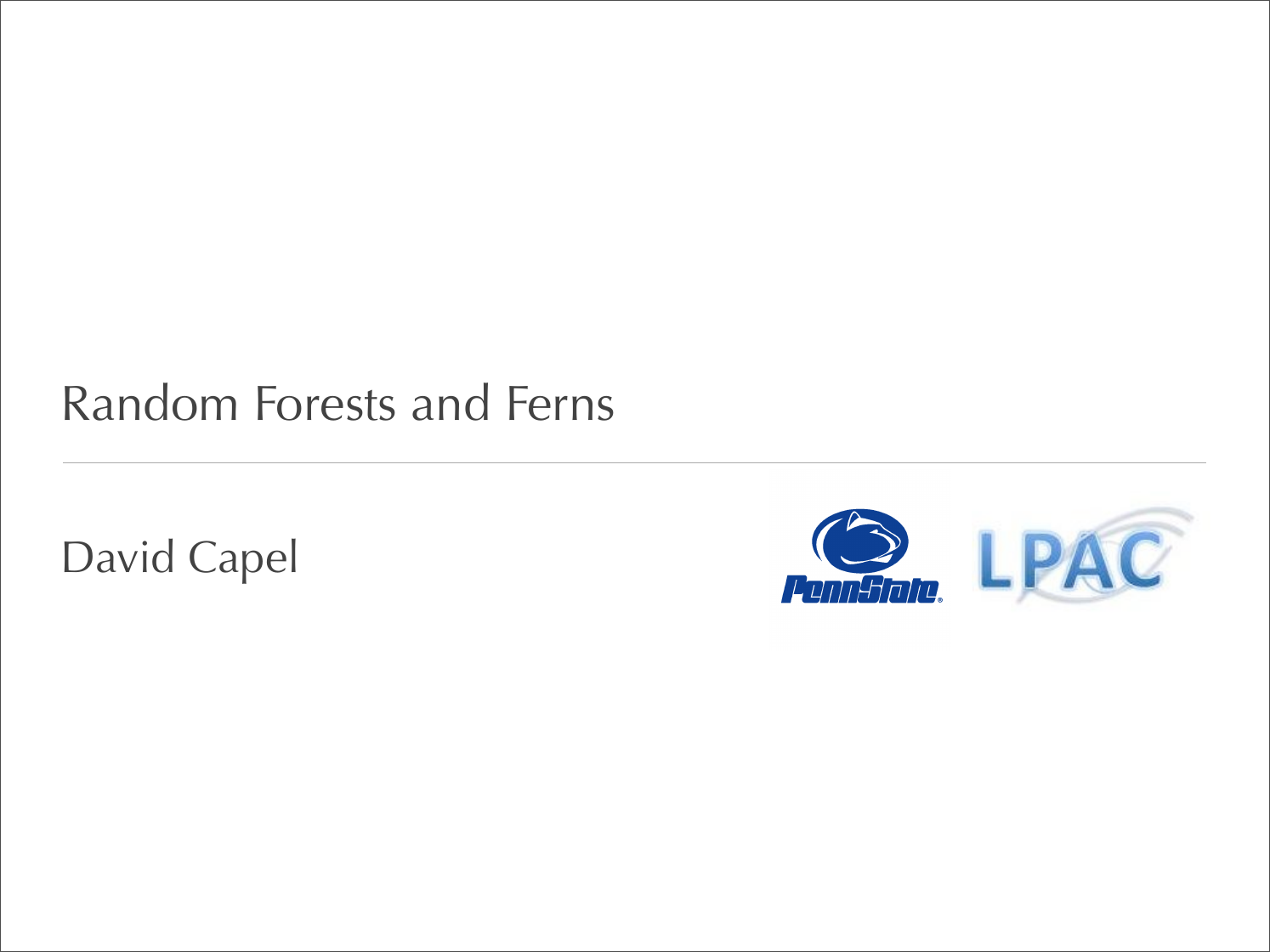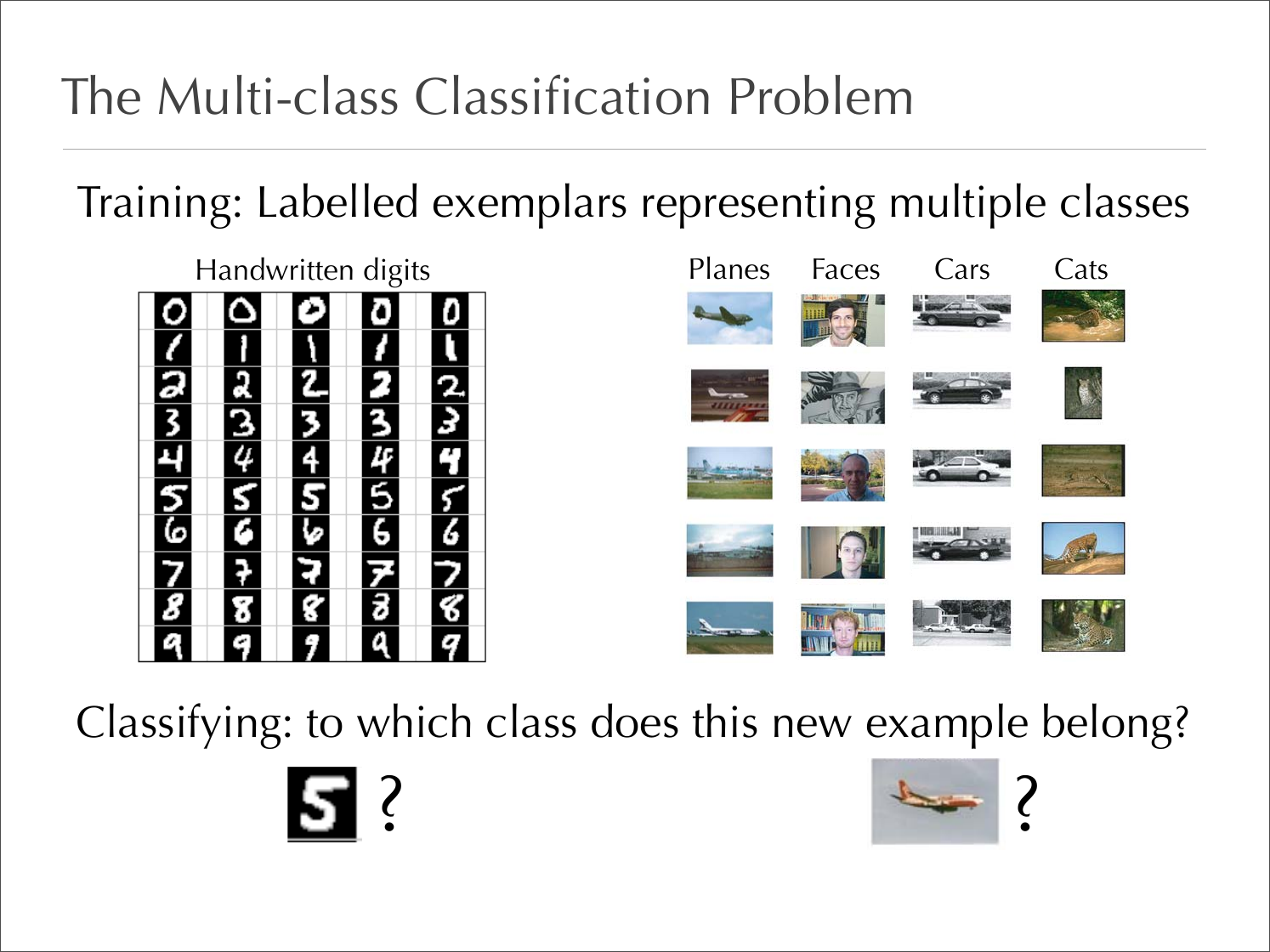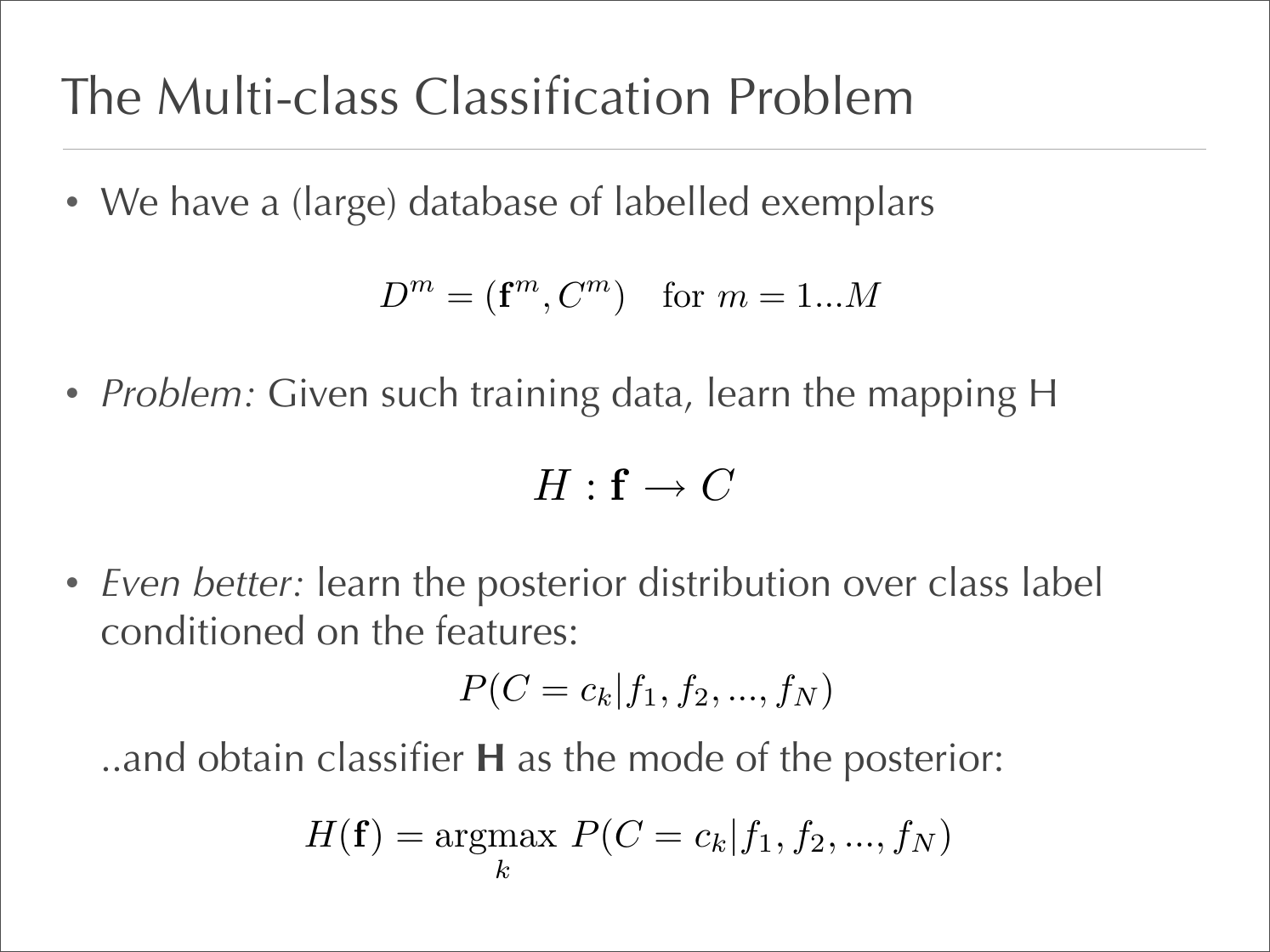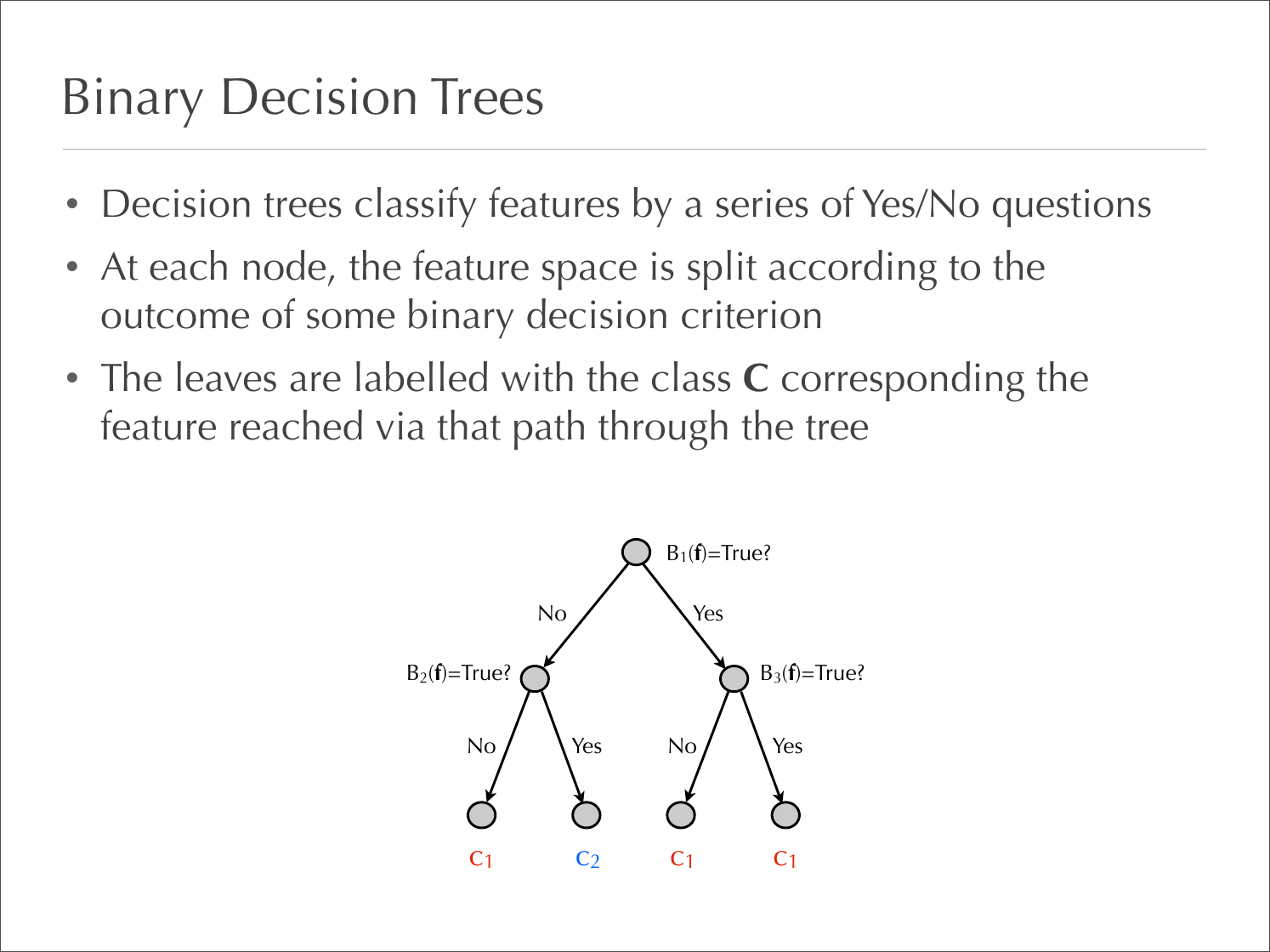Random Forests and Ferns
David Capel
�
The Multi-class Classification Problem
Fergus, Zisserman and Perona
276
276
Fergus, Zisserman and Perona
Training: Labelled exemplars representing multiple classes
Handwritten digits
Planes
Faces
Cars
Cats
276
Fergus, Zisserman and Perona
Classifying: to which class does this new example belong?
?
?
Figure 1. Some sample images from the datasets. Note the large variation in scale in, for example, the cars (rear) database. These datasets are
from both http://www.vision. caltech.edu/html-files/archive.html and http://www.robots. ox.ac.uk vgg/data/, except for the Cars (Side) from
(http://l2r.cs.uiuc.edu/ cogcomp/ index research.html) and Spotted Cats from the Corel Image library. A Powerpoint presentation of the figures
Figure 1. Some sample images from the datasets. Note the large variation in scale in, for example, the cars (rear) database. These datasets are
from both http://www.vision. caltech.edu/html-files/archive.html and http://www.robots. ox.ac.uk vgg/data/, except for the Cars (Side) from
(http://l2r.cs.uiuc.edu/ cogcomp/ index research.html) and Spotted Cats from the Corel Image library. A Powerpoint presentation of the figures
�
The Multi-class Classification Problem
• A classifier is a mapping H from feature vectors f to discrete
class labels C
f = (f1, f2, ..., fN)
C ∈ {c1, c2, ..., cK}
H : f → C
P (C = ci|f1, f2, ..., fN)
• Numerous choices of feature space F are possible, e.g.
H(f) = arg max
P (C = ci|f1, f2, ..., fN)
i
Dm = (f m, Cm)
for m = 1...M
Raw pixel values
Gij =
Texton histograms
1
2! 1
n"k
(d2
ik + d2
kj) − d2
ij −
Color histograms Oriented filter banks
kl#
d2
1
n2"kl
�
C ∈ {c1, c2, ..., cK}
H : f → C
The Multi-class Classification Problem
P (C = ci|f1, f2, ..., fN)
• We have a (large) database of labelled exemplars
P (C = ci|f1, f2, ..., fN)
H(f) = arg max
i
Dm = (f m, Cm)
for m = 1...M
• Problem: Given such training data, learn the mapping H
1
Gij =
• Even better: learn the posterior distribution over class label
H(f) = arg max
conditioned on the features:
..and obtain classifier H as the mode of the posterior:
1
kl#
d2
f = (f1, f2, ..., fN)
2! 1
n"k
n2"kl
C ∈ {c1, c2, ..., cK}
kj) − d2
ik + d2
(d2
ij −
H : f → C
f = (f1, f2, ..., fN)
P (C = ci|f1, f2, ..., fN)
C ∈ {c1, c2, ..., cK}
f = (f1, f2, ..., fN)
err(y) ="ij $Gij − y!i yj%2
C ∈ {c1, c2, ..., cK}
i
P (C = ck|f1, f2, ..., fN)
P (C = ck|f1, f2, ..., fN)
yαi =&λαvαi
2! 1
n"k
P (C = ci|f1, f2, ..., fN)
H : f → C
H : f → C
P (C = ck|f1, f2, ..., fN)
for m = 1...M
P (C = ck|f1, f2, ..., fN)
for m = 1...M
1
kj) − d2
Dm = (f m, Cm)
ik + d2
n2"kl
H(f) = argmax
Dm = (f m, Cm)
H(f) = argmax
k
for α =1,2,...,d
ij −
(d2
k
kl#
d2
1
Gij =
�
How do we represent and learn the mapping?
In Bishop’s book, we saw numerous ways to build
multi-class classifiers, e.g.
• Direct, non-parametric learning of class posterior (histograms)
• K-Nearest Neighbours
• Fisher Linear Discriminants
• Relevance Vector Machines
• Multi-class SVMs
y
t
i
s
n
e
n
t
f1
i
l
i
e
x
p
e
g
d
E
Class A
Class B
0.2 0.4 0.6 0.8
1
1 ! Specificity
(c)
Center pixel intensity
Direct, non-parametric
f2
(d)
k-Nearest Neighbours
�
Binary Decision Trees
• Decision trees classify features by a series of Yes/No questions
• At each node, the feature space is split according to the
outcome of some binary decision criterion
• The leaves are labelled with the class C corresponding the
feature reached via that path through the tree
B1(f)=True?
No
Yes
B2(f)=True?
B3(f)=True?
No
Yes
No
Yes
c1
c2
c1
c1
�
Binary Decision Trees
• Decision trees classify features by a series of Yes/No questions
• At each node, the feature space is split according to the
outcome of some binary decision criterion
• The leaves are labelled with the class C corresponding the
feature reached via that path through the tree
f
B1(f)=True?
B1(f)=True?
No
Yes
B2(f)=True?
B3(f)=True?
No
Yes
No
Yes
c1
c2
c1
c1
�
Binary Decision Trees
• Decision trees classify features by a series of Yes/No questions
• At each node, the feature space is split according to the
outcome of some binary decision criterion
• The leaves are labelled with the class C corresponding the
feature reached via that path through the tree
f
B1(f)=True?
B1(f)=True?
No
Yes
Yes
B2(f)=True?
B3(f)=True?
B3(f)=True?
No
Yes
No
Yes
c1
c2
c1
c1
�
















 2023年江西萍乡中考道德与法治真题及答案.doc
2023年江西萍乡中考道德与法治真题及答案.doc 2012年重庆南川中考生物真题及答案.doc
2012年重庆南川中考生物真题及答案.doc 2013年江西师范大学地理学综合及文艺理论基础考研真题.doc
2013年江西师范大学地理学综合及文艺理论基础考研真题.doc 2020年四川甘孜小升初语文真题及答案I卷.doc
2020年四川甘孜小升初语文真题及答案I卷.doc 2020年注册岩土工程师专业基础考试真题及答案.doc
2020年注册岩土工程师专业基础考试真题及答案.doc 2023-2024学年福建省厦门市九年级上学期数学月考试题及答案.doc
2023-2024学年福建省厦门市九年级上学期数学月考试题及答案.doc 2021-2022学年辽宁省沈阳市大东区九年级上学期语文期末试题及答案.doc
2021-2022学年辽宁省沈阳市大东区九年级上学期语文期末试题及答案.doc 2022-2023学年北京东城区初三第一学期物理期末试卷及答案.doc
2022-2023学年北京东城区初三第一学期物理期末试卷及答案.doc 2018上半年江西教师资格初中地理学科知识与教学能力真题及答案.doc
2018上半年江西教师资格初中地理学科知识与教学能力真题及答案.doc 2012年河北国家公务员申论考试真题及答案-省级.doc
2012年河北国家公务员申论考试真题及答案-省级.doc 2020-2021学年江苏省扬州市江都区邵樊片九年级上学期数学第一次质量检测试题及答案.doc
2020-2021学年江苏省扬州市江都区邵樊片九年级上学期数学第一次质量检测试题及答案.doc 2022下半年黑龙江教师资格证中学综合素质真题及答案.doc
2022下半年黑龙江教师资格证中学综合素质真题及答案.doc